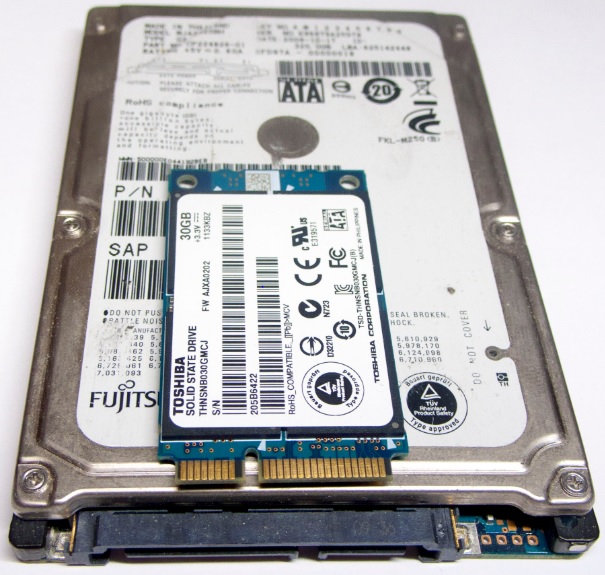A mSATA SSD is an SSD in much smaller formfactor. It is designed for use with portable, power-constrained devices like laptop, tablets and netbooks. The size of a mSATA is roughly like a business card. It has got all the functionality and benefits of SSD in it as it is an SSD, just with a different name. The main differences between the mSATA and a SATA SSD are physical size and the connectors. Rest, they both work on SATA III speeds meaning absolutely no difference in Read/Write speed. There are definitely some advantages of mSATA SSD over traditional 2.5-inch SSD as size while making compact definitely matters. mSATA SSD pros and cons are moreover like the SSD with some features added here and there.
With same SATA III speed but smaller formfactor, it can be beneficial to the smaller and more compact devices to save precious space. The only extra thing you will require is a special connector for the mSATA. You can somehow replace all your hard disk with mSATA SSD but you will face some other SSD drawbacks then like PE cycle, bit loss and others. You can buy some of the 1TB SSD from amazon. Some of the mSATA SSD pros and cons are listed in the sub-topics below.

Pros of mSATA SSD
- Formfactor
With the formfactor smaller than the 2.5-inch HDD and SSD, you can now save a lot of space. The devices like laptop, tablet and netbooks can now pack on some more hardware in their system as the storage option is small shaped with huge capacity. - Speed
It runs on SATA III speed. The read speed can reach up to 551 Mb/sec and the write speed maxes at 304 Mb/sec. the maximum bandwidth of a mSATA SSD is 6 gigabits per second (Gbps). - Power consumption
As a replacement for the HDD, mSATA SSD consumes very less power as there are no moving parts to power. This perk of mSATA SSD can be beneficial to run on the battery run systems like laptop, tablets, etc. - Storage
There are storage options available up to terabyte of memory. They are not only huge, but fast as well. You can store a lot of bigger files just like finger span. Loading OS into the mSATA will give you amazingly surprising boot time. For this, you can either buy smaller sized mSATA SSD in combination with bigger cheaper HDD. OS can be on faster partition and rest of the file in the slower drive. - Shock/vibration resistance
On the SSDs, you will see a protective hard case on them, on mSATA, it is bare piece of PCB with chips on them. Though, as it is securely mounted on the frame of the device, and having no movable parts, it is completely secure from shock and vibration. And it won’t produce any noise as well.
Further Reading: M.2 SSD Pros and Cons
Cons of mSATA SSD
- Price
The mSATA SSD is even costlier per gigabyte of storage than the SSD. When compared mSATA SSD with regular SSD, you will find SSD cheaper for the same storage option. The only perk is formfactor. - Compatibility
You must check for the compatibility of your device with the mSATA SSD as all mSATA SSD won’t be compatible with your system. You would better check before you buy one. - No performance difference
SSD and mSATA SSD work on same SATA III speeds with same read/write speed. Physically they are different, but performance wise, they both are same i.e. you won’t be benefitted from switch between mSATA and regular SSD except the compactness. - Connector
You will require to have a different mSATA connector already soldered on to the motherboard for the compatibility. The connectors of SSD and mSATA SSD are different. Most of the manufactures today include m.2 slot and mSATA slot in their devices so that the can be fitted later by the customer. - Limited PE cycle
The PE cycle of the mSATA SSD is limited making it susceptible to the bit loss. This means you will slowly but surely lose the bits and start degrading your storage. This might also result in early death of the device.
Conclusion
Hence, these are some of the mSATA SSD pros and cons. The technology is moving faster and with advancement every day, we feel slower every day. The newer generation of storage devices are faster, smaller, safer, but costlier than it used to be. As a conclusion, switching to newer devices are your personal preference but deciding whether to switch for them or not should be done analyzing their pros and cons. mSATA SSD is great storage option, but it might not be for everyone out there.
